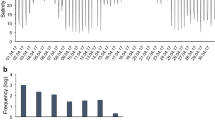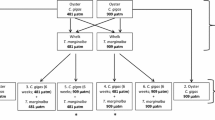Abstract
A shift in outcomes of predator-prey interactions in plankton community may occur at sublethal dissolved oxygen concentrations that commonly occur in coastal waters. Laboratory experiments were conducted to investigate how a decline in dissolved oxygen concentration alters the predation rate on fish larvae by two estuarine predators. Behavior and consumption of larval fish by moon jellyfish Aurelia aurita (103.1±12.4 mm in bell diameter) and by a juvenile piscivore, Spanish mackerel Scomberomorus niphonius (30.1±2.1 mm in standard length: SL), were observed under four oxygen concentration treatments (1, 2 and 4 mg l−1 and air-saturated: 5.8 mg l−1). Larvae of a coastal marine fish species, red sea bream Pagrus major (7.21±0.52 mm SL), were used as prey for the experiment. Bell contraction rate of the jellyfish did not vary among the oxygen concentrations tested, indicating a tolerance to low oxygen concentration. Gill ventilation rate of the Spanish mackerel increased and swimming speed decreased as the oxygen concentration decreased, indicating that oxygen concentrations ≤4 mg l−1 are physiologically stressful for this species. The number of larvae consumed in 15 min. by jellyfish increased whereas those consumed by Spanish mackerel decreased with the decrease in oxygen concentration. Low oxygen concentrations that are commonly observed in coastal waters of Japan during summer have the potential to increase the relative importance of jellyfish as predator of fish larvae and to change the importance of alternative trophic pathways in estuarine ecosystems.




Similar content being viewed by others
References
Aoki N (1999) Mechanism for establishment of hypoxic water and its movement. Kaiyo Monthly 31:477–485
Azeta M, Ikemoto R, Azuma M (1980) Distribution and growth of demersal 0-age red sea bream, Pagrus major, in Shijiki Bay. Bull Seikai Reg Natl Fish Res Inst 54:259–278
Bailey KM, Batty RS (1984) Laboratory study of predation by Aurelia aurita on larvae of cod, flounder, plaice and herring: development and vulnerability to capture. Mar Biol 83:287–291
Breitburg DL, Steinberg N, DuBeau S, Cooksey C, Houde ED (1994) Effects of low dissolved oxygen on predation on estuarine fish larvae. Mar Ecol Prog Ser 104:235–246
Breitburg DL, Loher T, Pacey CA, Gerstein A (1997) Varying effects of low dissolved oxygen on trophic interactions in an estuarine food web. Ecol Monogr 67:489–507
Collins MR, Wenner CA (1988) Occurrence of young-of-the-year king, Scomberomorus cavalla, and Spanish, S. maculatus mackerels in commercial-type shrimp trawls along the Atlantic coast of the southeast United States. Fish Bull 86:394–397
Costello JH, Colin SP (1994) Morphology, fluid motion and predation by the scyphomedusa Aurelia aurita. Mar Biol 121:327–334
Fukuhara O (1985) Functional morphology and behavior of early life stages of red sea bream. Bull Jap Soc Sci Fish 51:731–743
Hunter JR (1981) Feeding ecology and predation of marine fish larvae. In: Lasker R (ed) Marine fish larvae. University of Washington Press, Seattle, pp 33–77
Ishii H (2001) The influence of environmental changes upon the coastal ecosystems, with special reference to mass occurrence of jellyfish. Bull Plank Soc Jap 48:55–61
Ishii H, Tanaka F (2001) Food and feeding of Aurelia aurita in Tokyo Bay with an analysis of stomach contents and a measurement of digestion times. Hydrobiologia 451:311–320
Keister JE, Houde ED, Breitburg DL (2000) Effects of bottom-layer hypoxia on abundances and depth distributions of organisms in Patuxent River, Chesapeake Bay. Mar Ecol Prog Ser 205:43–59
Kishida T (1989) Distribution and migration of Japanese Spanish mackerel based on the catch and effort data in the central and western Seto Inland Sea. Bull Nansei Reg Natl Fish Res Inst 22:13–27
Kishida T, Aida K (1989) Maturation and spawning of Japanese Spanish mackerel in the central and western Seto Inland Sea. Bull Jap Soc Sci Fish 55:2065–2074
Kramer DL (1987) Dissolved oxygen and fish behavior. Environ Biol Fish 18:81–92
Matanoski JC, Hood RR, Owens RL, Purcell JE (2004) Patterns in swimming by a scyphomedusa: a novel approach to quantifying behavior in individuals. Mar Biol 145:303–313
Mills CE (2001) jellyfish blooms: are populations increasing globally in response to changing ocean conditions? Hydrobiologia 451:55–68
Möller H (1984) Reduction of a larval herring population by jellyfish predator. Science 224:621–622
Nakayama S, Masuda R, T Takeuchi T, Tanaka M (2003) Effects of highly unsaturated fatty acids on escape ability from moon jelly fish Aurelia aurita in red sea bream Pagrus major larvae. Fish Sci 69:903–909
Nixon SW (1988) Physical energy inputs and the comparative ecology of lake and marine ecosystems. Limnol Oceanogr 33:1005–1025
Ochi T, Nishio S, Okaichi T (1978) Anoxic water in the eastern area of Hiuchi Nada. Bull Agric Dep Kagawa Univ 29:297–304
Officer CB, Biggs RB, Taft J, Cronin LE, Tyler MA, Boynton WR (1984) Chesapeake Bay anoxia: origin, development, and significance. Science 223:22–27
Okaichi T, Komori S, Nakanishi H (eds) (1996) Biological resources and environment of the Seto Inland Sea. Koseisha-koseikaku, Tokyo
Renaud ML (1986) Hypoxia in Louisiana coastal waters during 1983: implication for fisheries. Fish Bull 84:19–26
Rombough PJ (1988) Respiratory gas exchange, aerobic metabolism, and effects of hypoxia during early life. In: Hoar WS, Randall DJ (eds) Fish physiology XI. The physiology of developing fish. A. Eggs and larvae. Academic Press, San Diego, pp 59–161
Shoji J, Tanaka M (2001) Strong piscivory of Japanese Spanish mackerel larvae from their first feeding. J Fish Biol 59:1682–1685
Shoji J, Maehara T, Aoyama M, Fujimoto H, Iwamoto A, Tanaka M (2001) Daily ration of Japanese Spanish mackerel Scomberomorus niphonius larvae. Fish Sci 67:238–245
Shoji J, Maehara T, Takichi A, Tanigawa T, Murata N, Tanaka M (2002) Larval fishes collected in Hiuchi-nada, the central Seto Inland Sea, Japan. Bull Jap Soc Sci Fish 68:835–842
Shoji J, Masuda R, Yamashita Y, Tanaka M (2005) Predation on fish larvae by moon jellyfish Aurelia aurita under low dissolved oxygen concentrations. Fish Sci 71:748–753
Sullivan BK, Garcia JR, Klein-MacPhee G (1994) Prey selection by the scyphomedusan predator Aurelia aurita. Mar Biol 121:335–341
Suzuki T, Matsukawa Y (1987) Hydrography and budget of dissolved total nitrogen and dissolved oxygen in the stratified season in Mikawa Bay, Japan. J Oceanogr Soc Jap 43:37–48
Tanaka M (1980) The ecological studies on the larvae and juveniles of the red sea bream in Shijiki Bay-I The horizontal distribution of the pelagic larvae and juveniles in and outside the bay. Bull Seikai Reg Natl Fish Res Inst 54:231–258
Toyokawa M, Furota T, Terazaki M (2000) Life history and seasonal abundance of Aurelia aurita medusae in Tokyo Bay, Japan. Plank Biol Ecol 47:48–58
Uye S (2002) Chain in coastal pelagic water. Monthly Kaiyo Spec Publ 29:137–142
Uye S (2004) Recent increase of the scyphomedusa Aurelia aurita and associated nuisance to fisheries in the Inland Sea of Japan. Bull Jap Soc Sci Fish 70, 387–391
Uye S, Ueta, U (2004) Recent increase of jellyfish populations and their nuisance to fisheries in the Inland Sea of Japan. Bull Jap Soc Fish Oceanogr 68:9-19
Uye S, Fujii N, Takeoka H (2003) Unusual aggregations of the scyphomedusa Aurelia aurita in coastal waters along western Shikoku, Japan. Plank Biol Ecol 50:17–21
Veer HW van der, Bergman MJN (1986) Development of tidally related behaviour of a newly settled 0-group plaice (Pleuronectes platessa) population in the western Wadden Sea. Mar Ecol Prog Ser 31:121–129
Yasuda T (2003) Biology of jellyfish. In: Yasuda T (ed) Jellyfish-UFO in the sea: occurrence, ecology, and measure. Koseisha-Koseikaku, Tokyo, pp 1–137
Acknowledgements
We express our thanks to Dr. D.L. Breitburg, Smithsonian Environmental Research Center, for teaching the experimental protocol and Dr. E.D. Houde, Chesapeake Biological Laboratory, University of Maryland, Dr. Mark Wuenschel, NOAA Beaufort Laboratory, and two anonymous reviewers for providing valuable comments on the manuscript. Thanks are due to Mr. A. Iwamoto and staff of JASFA for providing Spanish mackerel eggs and Dr. H. Motoh and staff of KPSFC for providing red sea bream eggs. All experiments were conducted in Japan, and were in compliance with the current laws.
Author information
Authors and Affiliations
Corresponding author
Additional information
Communicated by T. Ikeda, Hakodate
Rights and permissions
About this article
Cite this article
Shoji, J., Masuda, R., Yamashita, Y. et al. Effect of low dissolved oxygen concentrations on behavior and predation rates on red sea bream Pagrus major larvae by the jellyfish Aurelia aurita and by juvenile Spanish mackerel Scomberomorus niphonius. Marine Biology 147, 863–868 (2005). https://doi.org/10.1007/s00227-005-1579-8
Received:
Accepted:
Published:
Issue Date:
DOI: https://doi.org/10.1007/s00227-005-1579-8




